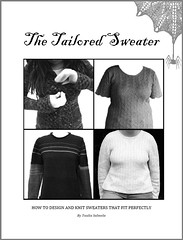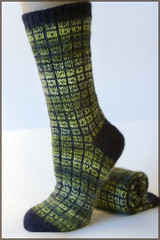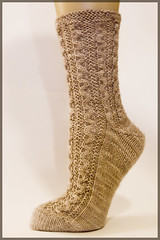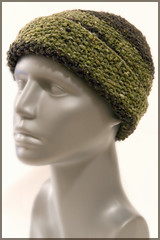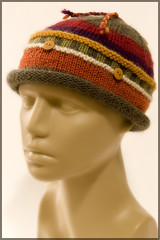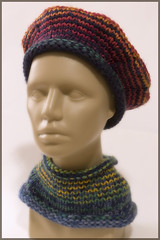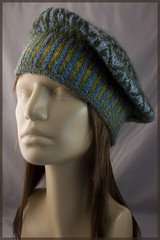I’ve had lots of requests from folks that like the short row heel in the
Lifestyle Socks pattern – but they often get lost between the “held” stitches and the “active” stitches. Here are a few tutorials using the same short row method with stitch markers to help hold your place. The instructions and videos below are for knitting a heel in a stranded colorwork sock. The heel is knit in one color of yarn. Assumption is that you are knitting in the round on two circular needles. The heel is knit on only one of the circular needles, and the other half of the sock stitches sit on the other needle, ignored while you create the sock heel.
Don't be daunted by the long-winded instructions -
skip right to the videos. It's easier to
see how to do it than to explain how to do it!
Knit the “short rows”
1. On needle 1 knit to one stitch before the last stitch on the needle (you do not knit the last stitch).
2. Place a stitch marker in front of that last stitch on Needle 1.
3. Turn the work.
4. Slip the first stitch as if to purl.
5. Purl all the stitches down to one stitch before the last stitch on your needle. (you do not knit the last stitch).
6. Place a stitch marker on the left needle, in front of the un-knit stitch.
7. Turn the work.
You will now continue knit rows and purl rows over the stitches on Needle 1, knitting or purling one stitch
short of the stitch markers. Move the un-knit stitch in front of the marker to the right needle, remove the marker, move the un-knit stitch you just place on the right needle to the left needle. Place the stitch marker on the left needle. Turn the work, while making the short rows, always slip the first stitch as if to purl. Continue until you have reduced down to 12 “active” stitches and have just finished a purl row.
Video illustrating knitting the short rows:
Add held stitches back into the work.
Turn the work, slip the first stitch, and knit 11 of the 12 center active stitches, your needle will look like this:
Left needle Right needle
[000000000000000 M X] [XXXXXXXXXXX M 000000000000000]
0 = held stitch; M = stitch Marker, X = active stitches
To help orient you, on the right needle you have held stitches, a stitch marker, and 11 active stitches. On the left needle you have the un-knit last active stitch, represented here as X on the left needle. A stitch marker (M) sits in front of the held stitches. Dependent on size of yarn and your foot, the number of held stitches will vary.
You will now begin adding the held stitches back, one row at a time, continuing to knit back and forth.
1. Move 1st stitch on the left needle to the right needle (this is the last active stitch you have not yet knit).
2. Remove the stitch marker on the left needle.
3. Slip the first stitch on the right needle back to the left needle (that last active stitch you have not yet knit.)
4. Knit 2 together.
5. Make 1 stitch (go under the entire next stitch, not just one side or leg of it, and pull up a new stitch.) Pull that new stitch pretty tight.
6. Place the stitch marker on the left needle.
7. Turn your work.
8. Slip the first stitch (this is the M1 stitch you just created.)
9. Purl (or knit, as appropriate) one stitch short of the stitch marker.
For a colorwork sock (assumption is that you are doing colorwork on the foot and the sock leg, the heel and toe are knit in one color) – you will repeat steps 1-9 until 2 stitches are still held on each side of the marker and you have just completed a purl row. Turn, knit to marker, remove marker, and knit the remaining 2 stitches on the needle.
If you are knitting in one color, you will add in all the held stitches.
Video illustrating adding the held stitches back into work:
Also, here are a few videos to help with colorwork management:
How to knit with two colors using two hands:
How to catch or weave in the yarn when it must be stranded over several stitches:
























